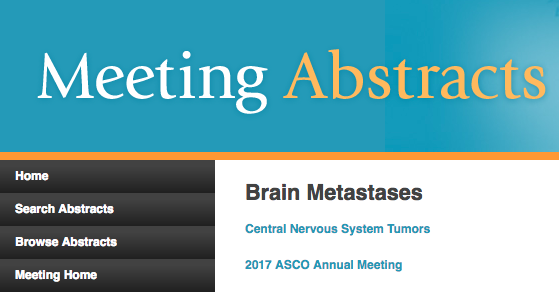Cambridge Brain Mets Trial 1 (CamBMT1): A proof of principle study of afatinib penetration into cerebral metastases (mets) for patients (pts) undergoing neurosurgical resection, combined with low-dose, targeted radiotherapy (RT)—Phase 1b results.
Sub-category:
Brain Metastases
Category:
Central Nervous System Tumors
Meeting:
2017 ASCO Annual Meeting
Abstract No:
2008
Citation:
J Clin Oncol 35, 2017 (suppl; abstr 2008)
Author(s): Richard D. Baird, Javier Garcia-Corbacho, Constanza Linossi, Sanjeev Srinivas Kumar, Donna Smith, Michael Williams, Wendi Qian, Andrea Machin, Saif Ahmad, Tomasz Matys, Raj Jena, Simon Pacey, Carlos Caldas, Duncan Ian Jodrell, Sarah Jefferies, Stephen Price, Colin Watts, Nicola Ramenatte; Cambridge Cancer Trials Centre, Cambridge, United Kingdom; Cancer Research UK Cambridge Institute – Pharmacokinetics and Bioanalytics Core Facility, Cambridge, United Kingdom; University of Cambridge, Cambridge, United Kingdom; University of Cambridge, Department of Oncology, Cambridge, United Kingdom; Cambridge University Hospitals, Cambridge, United Kingdom; Division of Neurosurgery, Department of Clinical Neurosciences, University of Cambridge, Cambridge, United Kingdom
Background: Failure of drugs to cross the blood brain barrier (BBB) can be a major reason for treatment failure in pts with brain tumours. Preliminary data suggest that low-dose RT may disrupt the BBB, and could facilitate increased drug delivery into brain tumours. CamBMT1 is a phase 1b/2 pre-operative window-of-opportunity trial designed to test if the delivery of afatinib into brain mets might be enhanced by targeted, low dose-RT. Methods: Pts with operable brain mets from breast or lung origin were treated with afatinib for 11 days prior to surgery on day 12. Pts also received a single fraction of targeted RT on day 10 (pts in either 2Gy or 4Gy arm). In phase 1b, afatinib dose (20, 30, or 40mg QD) was escalated in each arm using an accelerated titration design. Primary endpoint: steady-state afatinib concentration in resected brain mets, compared with plasma. Secondary endpoints: safety and tolerability. Results: 10 pts were treated (4 breast, 6 lung), with no dose-limiting toxicities seen, thus completing recruitment to phase 1b. Treatment was generally well tolerated. Median afatinib concentrations on day 12 were: plasma 22.7ng/mL (range 9.94-179); and tumour 405ng/g (range 120-1129). Conclusions: It was feasible to conduct a window-of-opportunity study of afatinib plus RT in pts with operable brain mets. The recommended phase 2 dose of afatinib was 40mg QD for both 2Gy and 4Gy arms. Afatinib concentrations in resected tumour were on average >15-fold higher than those in plasma. Phase 2 of CamBMT1 is now underway in multiple UK sites, and randomises patients into 3 treatment arms (n=20 per arm): 1. afatinib 40mg QD; 2. afatinib 40mg QD + 2Gy# RT; 3. afatinib 40mg QD + 4Gy# RT. Clinical trial information: NCT02768337

